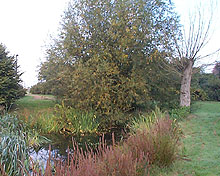 |
||||||||||
 |
||||||||||
 |
||||||||||
| On Saturday 22nd August 1789 the whole of Milton Keynes Parish was up for sale. If you called into the Swan Inn Newport Pagnell on that date you would have had the chance to bid for the whole estate but make sure you had the 10 percent deposit handy.
The agents for the estate advertised the sale and promoted the location of Milton Keynes as a major selling point. "The Eftate adjoins the turnpike road leading to Northampton; is well situated in refpect to Markets , being only Three miles from Newport Pagnel, Six from Wobourne, Five from Stony Stratford, and Forty Eight from London". Turnpike roads were the motorways of the day and were speeding up horse and coach travel around the country. People will still say location is everything when it comes to selling property. This sales approach was unsurprisingly being used by the Milton Keynes Development Corporation 200 years later when they were promoting the new city with its proximity to motorway and rail links. The whole estate comprised of "1802 Acres 3 Rods and 9 Perches" which generated "1957 pounds 3 Shillings and Eight pence" from its tenants. For younger readers not familiar with these arcane units of measurement an Acre is 160 square Rods, a Rod is a square Perch or 30.25 square yards and a Perch is 5.5 yards. You might need to find an older person to explain about Pounds, Shillings and Pence and if they can remember using Perches they are extremely old or teasing you. Now you can see why it was a good thing the metric system was invented. The sale included all the farms, houses, ponds, orchards, fishing rights, rights to cut reeds, a Rectory and even the Swan public house in the village. The estate inventory for the sale lists all the tenants and the date of their tenancies commencing. The tenancies were usually for 21 years commencing or renewed on "Ladyday" (25th March). The inventory even included every Cow gate on the estate and small plots of land know as Doles. Doles were parts of fields let to a number of tenants that rotated on an annual basis to ensure some sort of fairness on who had the best growing ground. Old traditions of drawing lots or wooden balls for these doles still exist in some parts of the country and it is the origin of the expression to dole or share things out. |
||||||||||
 |
||||||||||
 |
||||||||||
 |
||||||||||
| Back to top | ||||||||||